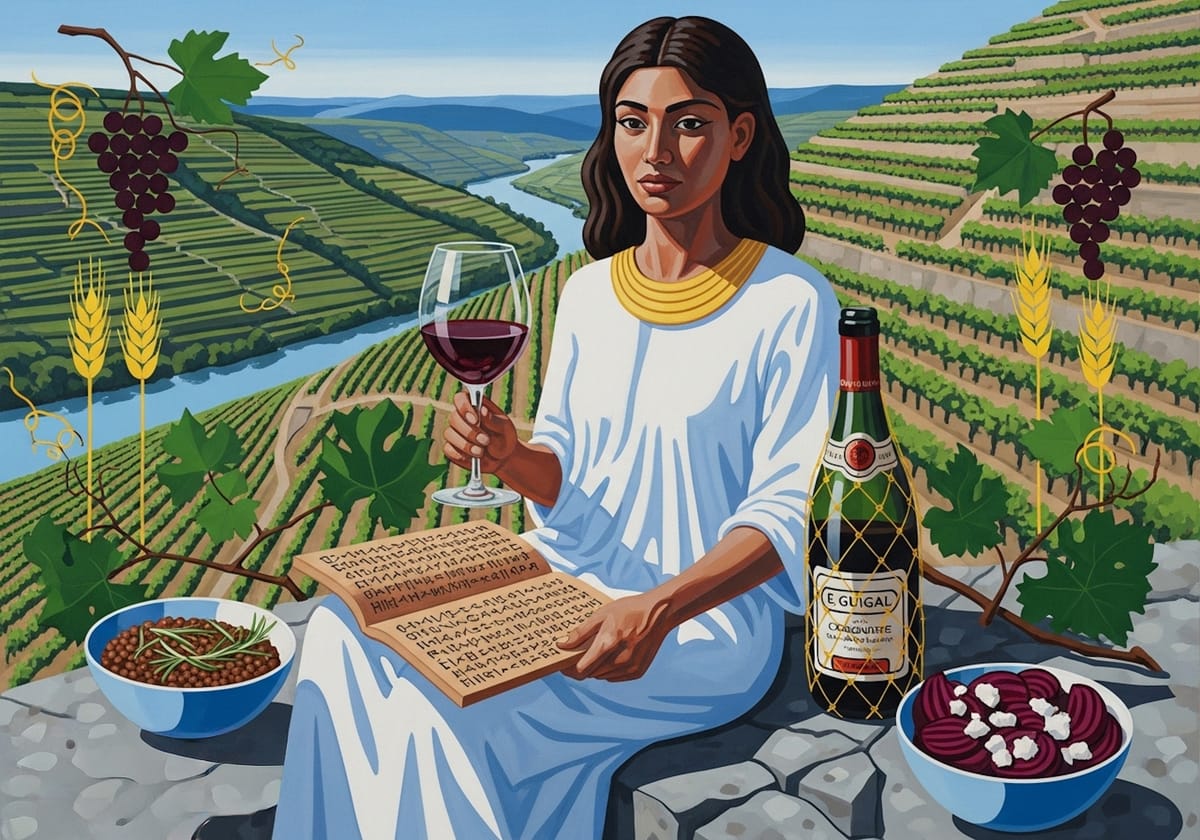Fire and Perfume on the Côte Blonde: E. Guigal Côte-Rôtie La Mouline 2015
A poetic exploration of E. Guigal Côte-Rôtie La Mouline 2015 food pairing—quail, figs, chestnuts, and truffled roots sung by the goddess Gesh.

The glass shimmers like garnet satin lit by dusk. I tilt it toward the light—the color deepens to blood-red velvet. A swirl releases violets, black cherries, cedar ash, and a breath of roasted game. I let it breathe for an hour in the decanter, so the iron and graphite can loosen, the Syrah’s smoke can soften into song. At sixteen degrees Celsius, in a broad, tulip-bowled glass, it speaks with elegance rather than force.
From the Amphitheater of Wind and Fire
I have walked these slopes before—steep terraces carved into the Côte Blonde, where Guigal’s La Mouline vineyard curls like a crescent moon around the Rhône. France’s northern Rhône gives birth to this Syrah, laced with a trace of Viognier, the floral ghost that lifts its perfume. The soils are ancient schist and mica, glittering like old starlight, and each vine roots deep through fractured stone. Marcel and Philippe Guigal tend them by hand, coaxing grace from peril. The wind sweeps the terraces clean; the sun pours down like molten bronze. The result is a wine that feels elemental—air, stone, and flame fused in fruit.
The Wine’s Voice: Velvet Bound by Iron
The 2015 season brought a rare symmetry: ripe fruit under steady skies, nights cool enough to fix its perfume. La Mouline moves like silk over steel. Aromas of blackberry, dried rose, and smoked tea weave into flavors of plum skin, olive tapenade, and cedar ember. The tannins are fine yet persistent, the kind that press gently rather than grip, and the finish glows with the minerality of schist—a savory, stony echo that lingers for minutes. Time will stretch this beauty deeper, toward truffle and leather, between now and 2038.
Roast Quail and Charred Figs
Many reach for lamb here, but I prefer smaller game—a roasted quail brushed with honey and thyme, its skin crisp and lacquered, its sweetness tethered to the wine’s black-cherry heart. Or grilled pigeon served with charred figs and jus reduced to a whisper of smoke. The iron in the meat mirrors Syrah’s mineral spine; the caramelized edges awaken its fruit. These are not grand banquets but quiet rituals—meals that reveal, not overwhelm.
The Vegetal Dream
I have always loved the earth’s darker produce—the ones that sleep underground. For La Mouline, I summon a chestnut and porcini galette, its pastry brushed with brown butter, the filling rich with autumn’s humus and spice. Or lentils du Puy simmered in red wine and rosemary, topped with roasted beet and a crumble of aged goat cheese. The umami in these dishes might challenge lesser wines, but La Mouline holds steady, its acidity lifting the richness, its perfume of violet and pepper threading through every bite.
Embers and Small Blessings
Serve beside a purée of celeriac kissed with truffle oil, or sweet potatoes roasted until their edges crisp like parchment. A drizzle of pomegranate molasses wakes the wine’s fruit; a shaving of black olive ties it back to its northern Rhône soul. If you end the meal with cheese, choose a slice of aged Salers or Ossau-Iraty, their salt echoing the minerality of the wine’s close.
The Scribe of Vines Speaks
Long ago, I kept the records of the underworld, counting the seasons of death and renewal. When Dumuzi rose each spring, I rose with him—through the vine roots, through sap and bud, into fruit and ferment. La Mouline reminds me of that ascent: life shaped by descent, beauty ripened through endurance. Each glass feels like a resurrection, a testimony written in berry and smoke.
A Blessing for Those Who Wait
Pour it slowly. Let its perfume tell you when to speak and when to listen. The wine is vivid now, but in patience lies revelation: by the next decade it will hum with truffle, violet, and sun-warmed stone. La Mouline is not a wine to drink—it is a story to reread, each vintage a new verse in the song of granite and grace.





